#hairy hedge nettle
Text
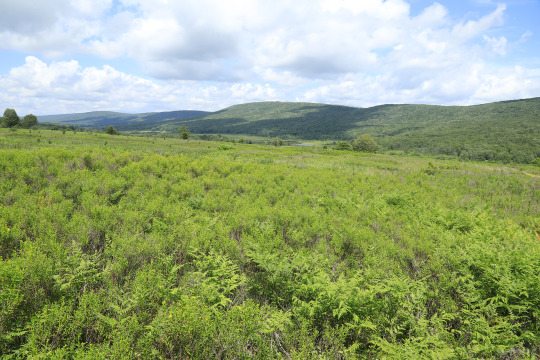
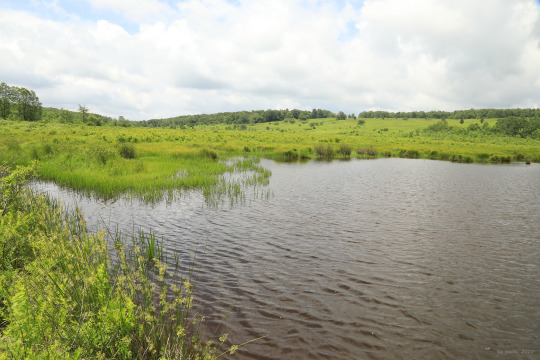


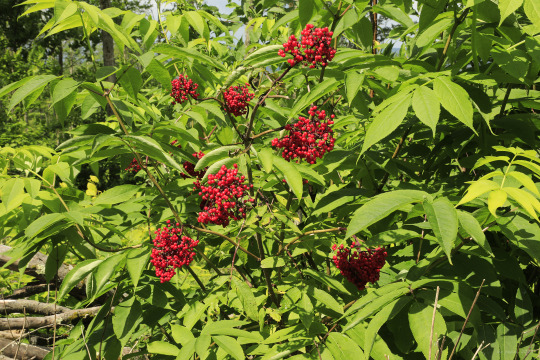
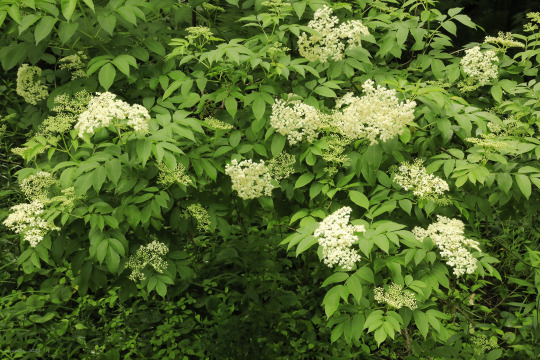


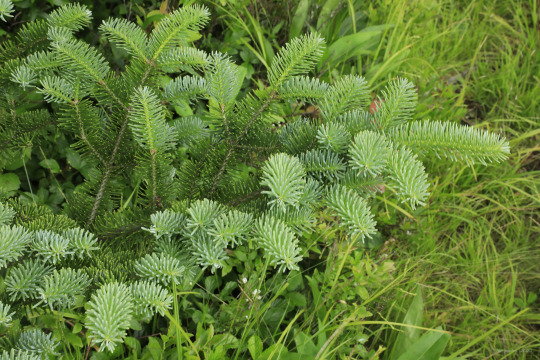


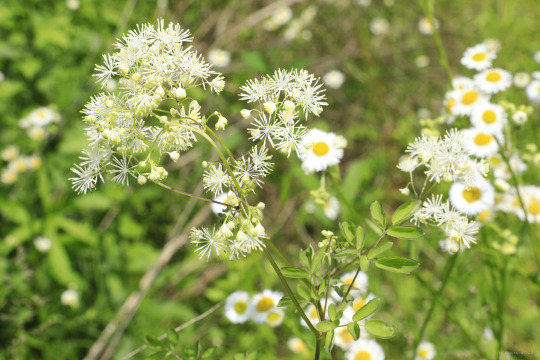

The northern end of Canaan Valley is characterized by regenerating northern hardwood forests interspersed with red spruce, open fields converting from pasture to heath, and beaver-curated wetlands. When the first white settlers arrived in the mid-1800's, the valley was a nearly impenetrable wilderness composed of mud-sucking "muskegs", gnarly rhododendron thickets, and monstrous stands of red spruce and eastern hemlock. Within 50 years, it was all gone, cut over and burned down down to bare rock. Salvation for this "Land of Canaan" has only recently come in the form of the Canaan Valley National Wildlife Refuge, which has set about the painstaking restoration of the valley's diverse (and occasionally threatened or endangered) plant and animal communities, some reaching their southernmost limits in these mountains.
From top: a view toward Cabin Mountain from Middle Ridge, whose open flank is overrun by lowbush blackberry, mountain laurel, bushy St. John's wort, bracken fern, and dotted hawthorn; several of the beaver-engineered wetlands, a mecca for birdwatchers from throughout the Mid-Atlantic region; the blazing red berries of red elderberry (Sambucus racemosa), a hugely important food source for local wildlife; the fanning white corymbs of American black elderberry (Sambucus canadensis), which comes into bloom about two months after red elderberry; quaking aspen (Populus tremuloides), whose delicate leaves flutter in unison at the slightest breeze; a beautiful young Canaan fir (Abies balsamea var phanerolepsis), a subspecies of balsam fir whose fragrant, blue foliage and high needle retention have made it increasingly popular as an ornamental; a lovely patch of hairy hedge nettle (Stachys hispida), a stately native mint; tall meadow rue (Thalictrum pubescens), a wetlands-loving perennial that clumps impressively along streambanks and bog margins; and lowbush blueberry (Vaccinium angustifolium), whose berries are just now starting to ripen.
#appalachia#vandalia#west virginia#wildflowers#flora#allegheny mountains#canaan valley national wildlife refuge#canaan valley#wetlands#beaver ponds#red elderberry#red-berried elder#american black elderberry#canada elderberry#quaking aspen#canaan fir#hairy hedge nettle#tall meadow rue#king of the meadow
73 notes
·
View notes
Text
77
All morning they walked by water and never saw it. The tangle of trees hid it from sight, but surrounded them in its sound. The chattering run of clear bright water.
Simra’s mouth was dry and sour from the heat. He caught himself patting the waterskin looped to his belt, checking it, then caught himself checking again, hopeless and habitual, like a superstition. Why would it have changed? Blighted thing was empty that morning. Of course it was still empty now. Still empty, and still sweat stinging at his back and in his eyebrows. Feet still hurting, but when did they not?
There was no track through all this growth. Every step was a blow struck against the forest. A process of gnawing into its bulk, its mass, chased on by the sense it was healing behind you, would mend quicker than you could travel. Trap you.
Following the Kogaru, Simra stepped where they stepped, weeds and grasses, and Llolamae traipsed behind him. They weren’t comfortable here, he realised. No more than he was. Didn’t know how to move through forest like this, all crashing feet and the cutting switch of a spear against the knit of green ahead. Their people had lived on this island since before time had a name for itself. Generations and generations, living in the icewastes of the coastlines like as not. Life and living balanced between the sea and the hotcaves. Might be this place had still been the greenest piece of the island in Kaliklu’s younger years, but Dalvur Vedith brought the forest. It was recent; newer than anything like this ought to be. Not a forest, Simra corrected himself. A garden.
The light changed. One moment, filtered yellow sun and shadows of midnight green. Now things were luminous, sallow. Fungus reached in fronds, thin-stemmed up to left and right, like fences of growing willow. They ended capless in paintbrush tips, like blossoms almost, or the tendril-mouths of something that lived too deep under the sea to be understood by anything that didn’t. No glow to them that Simra could see, but then again there was no sunlight either. A smell on the air, like wax and turned earth and the sweetness of boiled milk.
Underfoot, nettles and weeds grew high as Simra’s waist. Pale-leafed and sticky on Simra’s clothes, they spooled and hedged together like messes of twine, and he tramped through them in long high clownish strides. Not a path, too thick-grown for that, but then why did the fungus either side feel like it’d been waiting for them? Ushered them into itself. Grown round them, maybe. A tunnel, a passage, a funnel.
To one side a tree was trying to grow, crashing up through the wall of fungus. Colourless craggy bark, dried up, and all its leaves starved to bones. The weeds crowded its trunk and had clambered choking into its branches. They sagged under the weight, overburdened, but up amongst them the weeds were flowering. Each was a pair of petals, lurid yellow and palm-sized, with a long smug purple needle hanging down.
Simra felt his mouth twist and tighten. He strayed as far as the fungus fence would let him, not keen to be under the weed-choked tree. Something pinched at his vision as he passed it by. Motion. He snapped his head up, back. His hand went for his belt, then slacked.
Butterflies. Moths maybe. A swarm of them, all big as his palm, swarmed between the branches in billowing stormclouds, wheeling scattering loops. Simra felt himself frown. Their wings were bright yellow and they searched the air with flickering tongues, thistle-flower purple.
“What in the—…”
Llolamae whooped and clapped her hands. Stopped and turned in place to watch them, mouth open and jaw hanging.
“There a reason Telvanni do things like that?” Simra said, stuck between the wonderment and wrongness of it. “Or is it just for the spice of it. See if they can.”
“Might have a reason.”
“Seeing if you can’s not a reason.”
“Might be an important one, even!” said Llolamae, neck still craned, keeping track of the moths.
“A weed that – let me straight this out – kills trees to make flowers that turn into moths, and then…fuck knows where that journey ends.”
“Seeing if you can’s important sometimes. That’s what Master Vidanu says. Testing principles, intit? You start small, and it might look like nothing, might even seem like a waste. But then who’s laughing when you reapply it somewhere else and of a sudden you’ve up and cured autumnsbone or gripe!”
“With moths…”
“Maybe.” Llolamae looked down, looked full at him, squaring her hips and shoulders.
“Fuck…” Simra muttered. “Well if I was waiting on a sign we were getting close… Come on. Let’s get this done.”
The fungus ended but Simra couldn’t quite place when. Gone in the time it took not to look at it. No fungus, no breeze, and back to daylight through the still leaves overhead, littering the ground like scraps and shatters of noontime gold. The weeds had given way to a dark velvet of moss, tending slippery and slow downhill.
Simra looked up from watching his feet, not wanting to stumble. A bright gap showed ahead in the closure of ferns and trees. The Kogaru disappeared through as Simra watched. He forgot the footing, his care of it, and hurried after them, muttering again, “Come on.”
With one hand he parted the greenery, opening the gap to fit through. Stiff hairy stems, one broken and bleeding what looked like bile. Delicate fronds, complex and intricate. Tiny leaves fitting together like tiles in a mosaic, like teeth in a clenched mouth. His other hand itched anxious at his belt, hovering between the hilt of his sword and handle of his knives.
“Come on…” Didn’t know if the words were meant to speed Llolamae behind him or steel himself for what was ahead. It was this place. Turning him round, putting a fear up him at seeing – what? – a stand of ferns. Then, sky, stark and open. A cut through the woodland, ten strides broad.
A deep narrow ribbon of water cut across the way and the Kogaru haunched down beside it, drinking from their cupped hands. Only the hunter stood back, leaning on his spear and glaring as Simra came through the ferns. Without looking down, the hunter lowered a hand to the bundle slung across his shoulders and brought out a flattened leather bottle, throwing it beside the youngest Kogaru who set to filling it.
Simra eyed the water. Crouched down beside it and sniffed, careful of it. Moss, moths, fungus that found you in the wilderness and fanfared your way with steepled stems — hadn’t yet found a thing in this basin he trusted. Just because he liked the look of this water didn’t mean he’d start trusting it too. How long had they walked beside it while it hid from them?
He wet his cracked lips. Unhitched his own waterskin, crushed the air out, and submerged it, giving it the side of his gaze as it filled. The water was so clear, seemed almost so still and steady in its running, that he scarce knew his hand was under it except by the chill of it. Deep and sharp, flooding up his wrist and into the bones of his arm. He was already longing for it. Thinking how it would ache in his teeth and unparch his throat. Freezing, high-mountain cold.
Wincing, Simra stood up and and passed the skin into his other hand, fluttering the wet one like that might fidget some feeling back into its fingers. Llolamae lurked by him and he passed her the uncapped skin. “Hold this a moment.”
Straight away she made to drink.
“Tscht! Hold on!”
She hesitated, mouth still open and skin raised almost up to it.
“I said hold it.” Simra cocked his eyebrows and jerked his head at the Kogaru, watching a moment. They were drinking free and open now, and weren’t dead yet, but all the same, all the same... He shuffled his old leather satchel round to his front. Picked through, staring into it, and came up with a length of plaited twine round his fingers, the coin-slight weight of a bronze medallion dangling from its length. It was wide across as a fingerjoint and tarnished green-blue by water — centuries of patina, he might’ve thought, if he hadn’t watched the streetmage etch her enchantment into it himself less than three years ago.
“What’s that do?” Llolamae asked.
“Makes water safe to drink,” he said, taking back the skin. Safe, unless someone put poison in it by design.
“By magic?”
He nodded. “Small thing, but it’s saved my life more times than any other blade or bit of magic I’ve ever owned.” Anycase, he liked to think it had. He’d never really know, not while it did its job, but since half the camp at Gelan-Telai went down with a blood-tinged flux, Simra reckoned one never could be too careful.
The medallion went into the neck of the skin and came out wet. No more tarnished though. Simra liked to think that meant something. He drank a measured draught. One clean, cold sip, then a long glug, cheeks filling, throat filling, then stomach cold and glad with it. “Ghosts…” he gasped. “Good.” He swilled out the sour corners inside his mouth, washing away the taste of thirst, and turned his back to Llolamae. Spat.
She took a quick gulp when he passed it to her then drained it dry.
Taking it back, Simra crouched to fill it again. Thoughtless, he found himself thinking, and something he thought stuck like a fishbone in the throat of his mind. Might be nothing. Maybe so, but it still itched. Looking down at the cut of the stream through the forest, it had no banks. No silt, no pebbles or gravel. Just the clean cleave of it, a deep brief trench through the moss and the pale solid stone beneath it. Like a gutter, sliced neat. Like something brand new.
Chewing the inside of his cheek, he dipped the medallion again and made himself look away from the water. Its stone bed, its strange slow run. There’d be no standing up for falling down if he let himself get tripped up on every scrap of strangeness in this place. Best just to carry on. Get this done. He’d been away long enough already.
5 notes
·
View notes
Text
Betony

stachy officinalis or betonica officinalis
Betony is also known as; St Brid’s Comb, Stachys betonica, woundwort, common hedge nettle, lousewort, purple betony, bishop wort, bishop’s elder, spiked betony
Betony is a woodland perennial and a member of the mint family with its characteristic square stem and bilabiate flowers. The flowers are lavender in colour and appear in whorls from June through August. The leaves and stems are hairy and fragrant. The plant appears along woodland edges and can reach up to two feet in height. Betony is a European native that has naturalised over much of the United States and is considered a weed in many areas.
History and Folklore
The name betony is said to derive from a Celtic word bewton which means “good for the head”.
The Egyptians regarded betony as a magical herb. A Spanish saying, “He has as many values as betony,” shows the regard that people had for the plant. The Romans listed 47 different medicinal uses for betony and believed that even wild beasts used betony as medicine, and would seek it out when wounded.
A common traditional use for betony was a guard against evil spirits and mischief. During the Middle Ages, it was planted in churchyards and worn in amulets for protection.
Household Use
Makes a chartreuse dye with an alum mordant.
Magical Attributes
Identified with attorlothe of the Nine Herbs Charm, Betony resonates with the energy of the planet Jupiter and the element fire and is masculine in nature.
Betony can be added to any protective mixtures, grown around the home to protect it or carried on the person (especially under one’s hat) to protect from negativity, misfortune, and hexes. Scattered near doors, it prevents unwanted energies (and people) from entering. It has been planted in graveyards to prevent evil spirits from escaping.
Betony can be stuffed into a pillow or placed underneath to prevent nightmares and night terrors.
https://witchipedia.com/book-of-shadows/herblore/betony/
0 notes